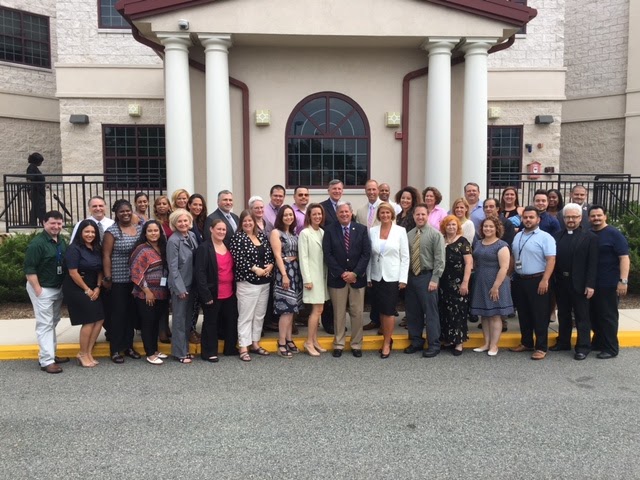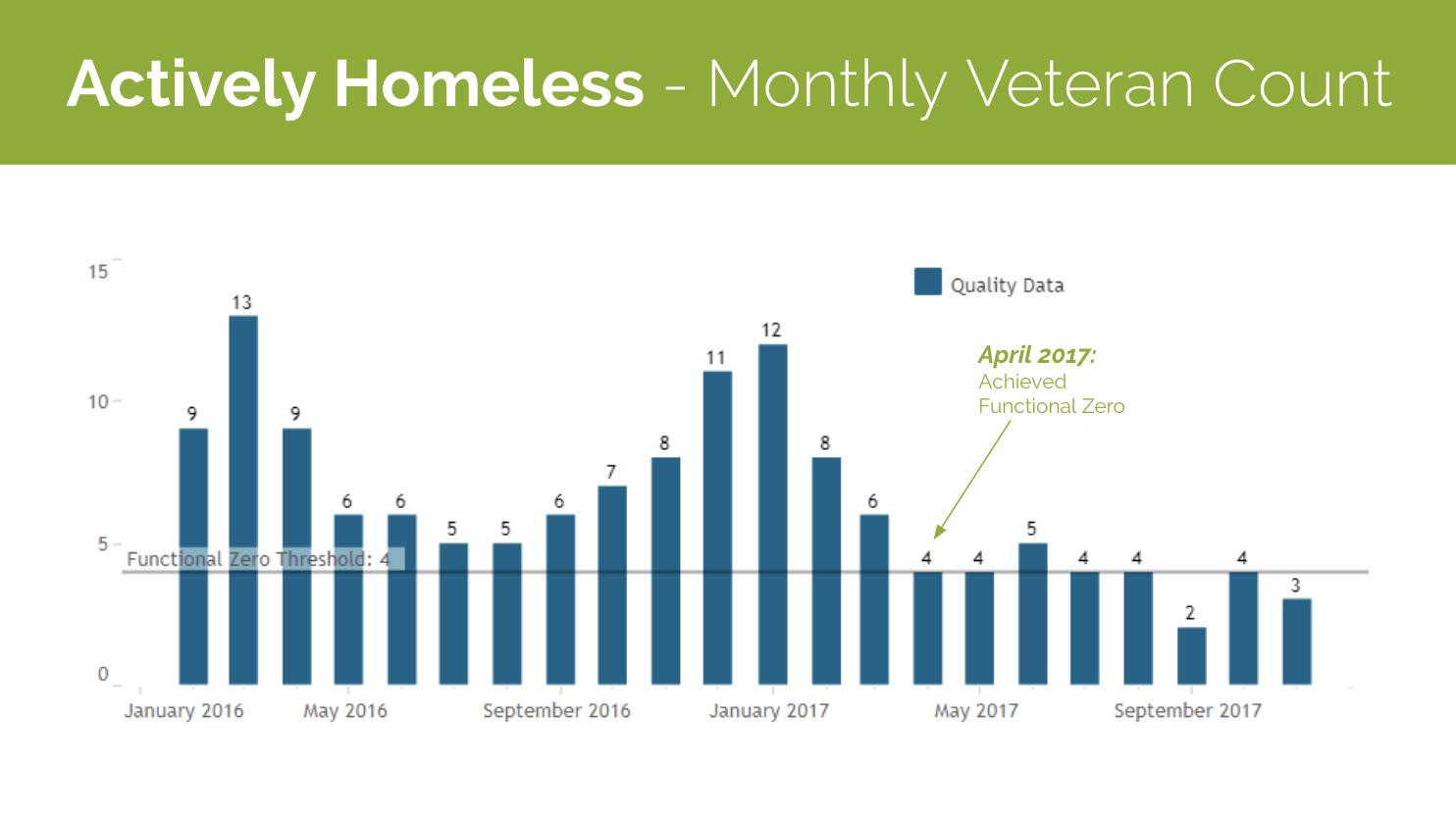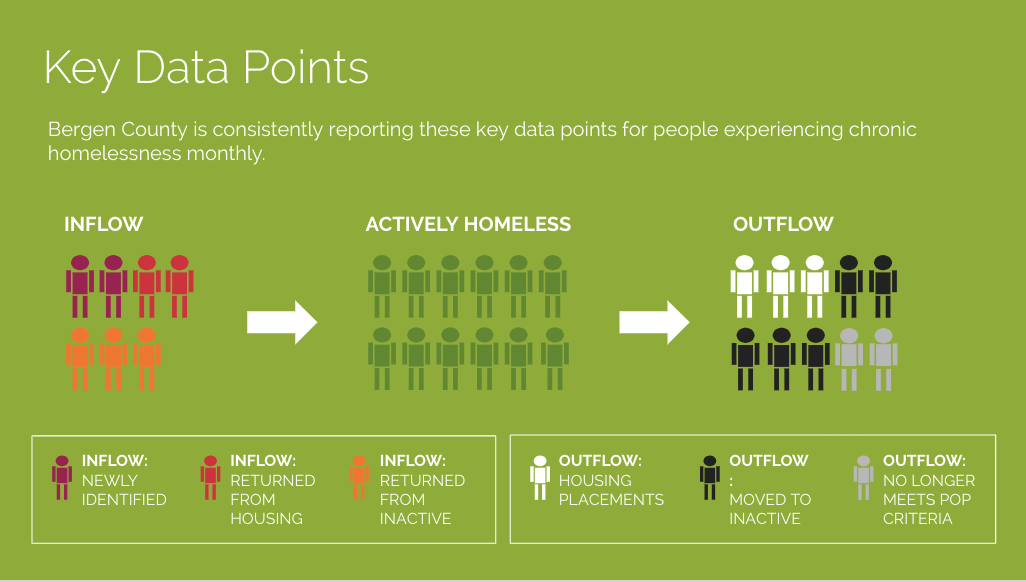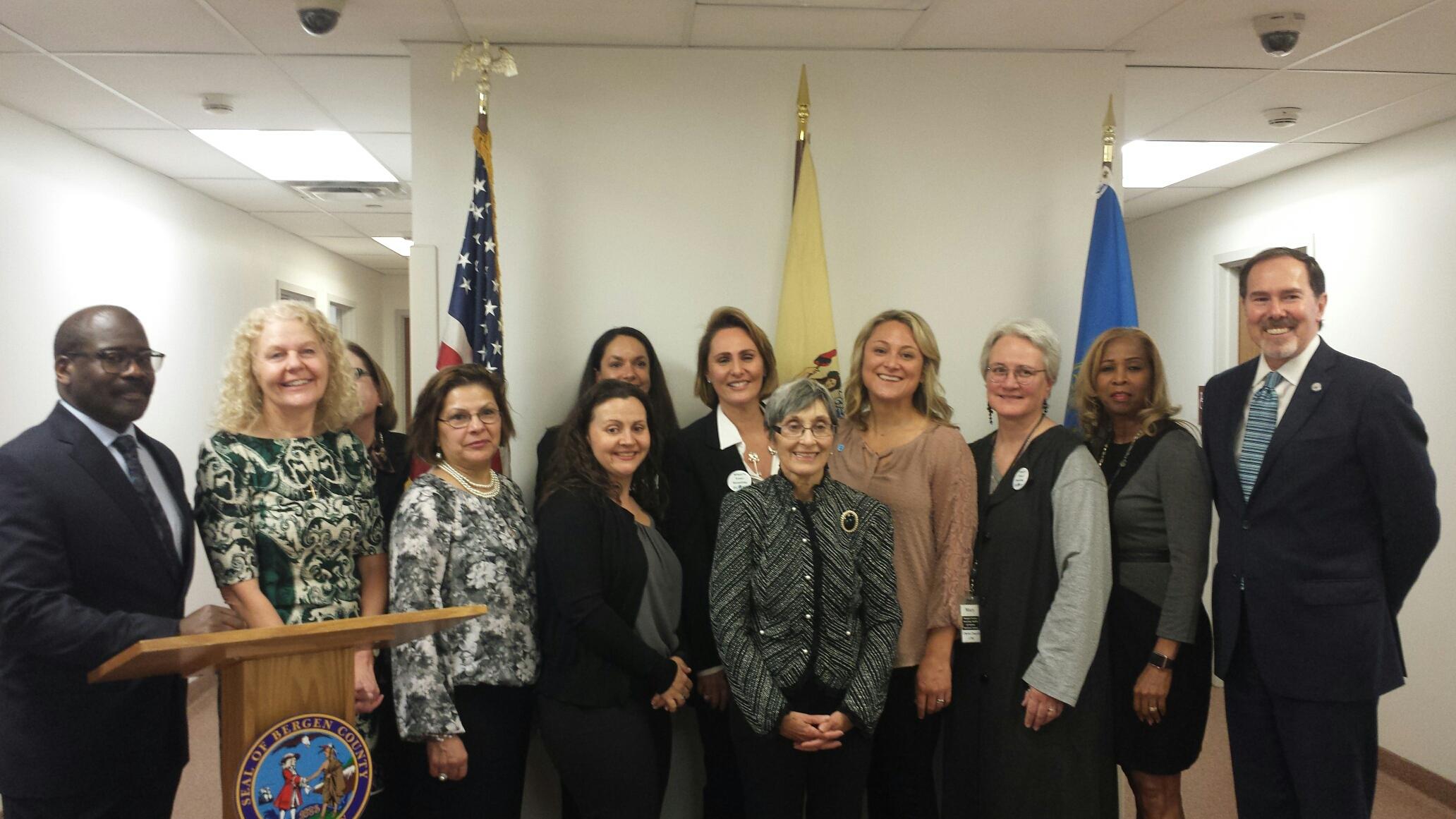COVERAGE AREA
Counties: 1
Total Population: 932,202
The Achievement
FUNCTIONAL ZERO
- Milestones Reached: Chronic (2016) and Veteran (2017)
- Next Population: Youth
Bergen County is one of only three communities in the country that have reached functional zero for both chronic and veteran homelessness. It is a part of Built for Zero, a movement of more than more than 80 communities committed to measurably ending homelessness, one population at a time. The Continuum of Care for Bergen County, New Jersey, worked with Community Solutions from the days of its 100,000 Homes Campaign and then joined Built for Zero at its inception in 2015.
In August of 2016, Bergen County became the first community in the United States to end chronic homelessness and reached zero people experiencing chronic homelessness.
Chronic homelessness describes people who have experienced homelessness for at least a year— either continuously or cumulatively through 4 or more episodes in the past 3 years— while struggling with a disabling condition such as a serious mental illness, substance use disorder, or physical disability.
A community has ended chronic homelessness when three or fewer people are experiencing chronic homelessness (or 0.1% of the community’s most recent total homelessness individual point-in-time count, whichever is greater). This definition is shared between Built for Zero and the federal government.
Six months later, Bergen County reached functional zero for veteran homelessness, demonstrating that there are fewer veterans experiencing homelessness than can be routinely housed within a month, which is five veterans in the community.
“Once you’ve ended homelessness for one group, nothing seems impossible,” said Julia Orlando, director of the Bergen County Housing, Health and Human Services Center and Built for Zero community lead in Bergen County.
By reaching functional zero for veteran homelessness, the community has proven it has built a system that can ensure homelessness is rare and brief, even if new veterans experience housing crises over time. They have sustained both functional zero milestones. Bergen has helped move more than 1,300 people into permanent housing since October 1, 2009— 95% of whom have stayed housed.
“We had the political will, we had the willing partners and the committed resources,” said AJ Luna, director of the Bergen County Division of Veteran Services. “We changed the question from why can’t it be done to why isn’t it being done.”

How did they do it?
As part of Built for Zero, Bergen County changed how its homeless response system works by adopting the core elements of the Built for Zero methodology:
- Building a unified regional team, or a “command center,” under one roof around a shared aim of getting to functional zero
- Using real-time, person-specific data to know every person experiencing chronic homelessness or veteran experiencing homelessness by name and target efforts and resources accordingly
- Using data to redesign Bergen’s homeless response and strategically target resources
BUILDING A COMMAND CENTER

The local Built for Zero team started by unifying the efforts of key agencies working locally to end homelessness. The team recalled an initial three-day workshop that convened all the agencies charged with helping people experiencing homelessness. This included the VA, local churches, social service agencies, and the local housing authority, HABC. When 40 or so people convened in one room to examine the issue, it became clear that the county had sufficient resources to cut homelessness; it just wasn’t deploying them efficiently or effectively.
In many communities, local agencies or nonprofits focus on their piece of the solution, without an ability to see how all the pieces in their community fit together. Often, success is defined by each organization’s programmatic goals rather than whether the overall number of people experiencing homelessness is going down.
Bergen County worked to reorganize their efforts around a shared goal of getting to zero on chronic homelessness and took it a step farther, physically moving agencies into the same building. The Bergen County Housing, Health And Human Services Center (BCHHHC) is a 27,000 square-foot building that serves as a “one-stop” facility that enables individuals to access shelter, food, medical evaluations and linkages to housing support. The BCHHHC serves as a single point of entry for people who need housing, although no individual needs to be in shelter to obtain housing. Learn more about who’s on the team.
Members of the local Continuum of Care have worked to ensure collaboration both inside and outside the walls of the BCHHHC in a philosophy local partners call “housing without borders.”
“We make it impossible to not be connected,” said Orlando, who is a trained disaster response professional. “We’ve brought the services to the people—we are not expecting them to go find all of the services.”
UNDERSTANDING THE PROBLEM THROUGH QUALITY REAL-TIME DATA

You cannot solve a problem that you don’t understand. In order to measurably end homelessness, communities need real-time, person-specific data. Traditionally, an understanding of the issue of homelessness in a community has been limited to an annual estimate of people experiencing homelessness, called the point-in-time count. This is an aggregate number that provides an estimate of people experiencing homelessness on a single night, but does not include the names or needs of the people who make up that number.
Communities in Built for Zero develop By-Name Lists, which provide real-time insights into everyone experiencing homelessness by name. This enables communities to triage that individual’s needs, understand if their investments and activities are driving homelessness down and test and innovate ideas that will move people out of homelessness faster.
By February 2016, the team had created a system that ensured quality data on every person experiencing chronic homelessness and every veteran experiencing homelessness. This data enabled them to understand who was moving out of homelessness, who was entering into it, and who was remaining on the list.
Once a month, a group of up to 40 providers come together and go through every single person on the list, matching individuals with the vacancies and resources they need to exit homelessness.
“It gives you a sense of urgency,” Orlando said. “When an organization helps you put together your targets or take down numbers and you’re able to see how many you’ve housed and you still have to house. And when you have to report that data nationally, that really lights a fire underneath you.”
Within six months of creating their by-name list of people experiencing chronic homelessness, Bergen County achieved functional zero.

USING DATA TO REDESIGN BERGEN’S HOMELESS RESPONSE AND TARGET RESOURCES
Orlando’s team can rattle off the names of people experiencing homelessness, which means they can develop response strategies and shift resources around in real time.
“People will make blanket statements like, we need more affordable housing,” Luna said. “But what we have now is the knowledge of what the data tells us we need. The data gives us a basis for the problem we’re looking at.”
The agencies within BCHHHC marshall resources and are committed to playing by the same rules to ensure they provide the appropriate support for individuals. The County’s coordinated assessment criteria dictate that people experiencing chronic homelessness are prioritized for permanent supportive housing—a long-term rental voucher connected to ongoing supportive services—while those with lesser needs are connected to effective, lower cost options.
The effect of the County’s coordinated assessment process has been to remove any shortcuts or secret side doors for its limited resources. This includes, for example, the 20% of housing vouchers that was committed to the coordinated system by Bergen’s public housing authority, HABC.
“We know the things that work: housing first, triaging using your by-name list, and using your resources in a really smart way,” Orlando said. “This makes sure that your most vulnerable are being assisted.”
What’s Next
Protecting Zero
To this day, the team of 40 still meets monthly to go through their By-Name List for veteran homelessness. Since they hit zero for chronic homelessness, they have developed an “at-risk” committee of people to ensure they can prevent people at risk of chronic homelessness from ever experiencing it.
“You have to protect zero,” Orlando said. “I can’t imagine us falling back.”
Since 2017, the community has been working to spread and scale its approach to ending homelessness for all. After reaching and sustaining functional zero for veterans and chronic homelessness, they are now working to reach functional zero for youth homelessness.
Timeline
2009
- Established a Single Point of Entry model Coordinated Entry System
- Adopted an early model of a By-Name List to provide individualized housing assistance
2011
- Bergen County joined the 100,00 Homes campaign, which aimed to house 100,000 people experiencing chronic homelessness across the U.S., and routinely exceeded its monthly housing targets.
2015
- Bergen County joins the Built for Zero movement to focus on ending homelessness among people experiencing chronic homelessness
2016
- February: Reached quality data on chronic homelessness and veteran homelessness
- August: Bergen County ended chronic homelessness
2017
- April: Bergen County ended veteran homelessness
Who was on the team?

Community and Data Lead:
Julia Orlando
Director
Bergen County Housing, Health and Human Services Center
Built for Zero Community Lead
Mary Sunden
Executive Director
Christ Church Community Development Corporation
Built for Zero Data Lead
The Team:
Angela Drakes
Deputy Director
Bergen County Division of Community Development
CoC Lead
Robert Esposito
Director
Bergen County Division of Community Development
CoC Lead
AJ Luna
Director of Veteran Services
Division of Veteran Services
Built for Zero Veteran Lead
James Tedesco III
County Executive
Bergen County
Mayor John P. Labrosse, Jr.
City of Hackensack, NJ
Kristina Portella
LAC, PATH Coordinator
CBH Care
CoC Street Outreach Lead
Alberto deLeon
CoC Street Outreach Lead
Candida Wiltshire
PATH Program Coordinator
Comprehensive Behavioral Healthcare
CoC Street Outreach Lead
Lynn Bartlett
Executive Director
Housing Authority of Bergen County (HABC)
PHA Lead
Nicola Burnett
Community Care Program Manager
VA NJ Healthcare System
VA Representative
Susan Nottingham
Supervisor, Planning and Contract Administrator
Bergen County Division of Community Development
HMIS Lead
VA Representative: Vic Carlson
CoC Board Consumer Representative: P. Nickels
Built for Zero Coach:
Julia Parshall
Improvement Advisor for Built for Zero
Jillian Fox
Improvement Advisor for Built for Zero




